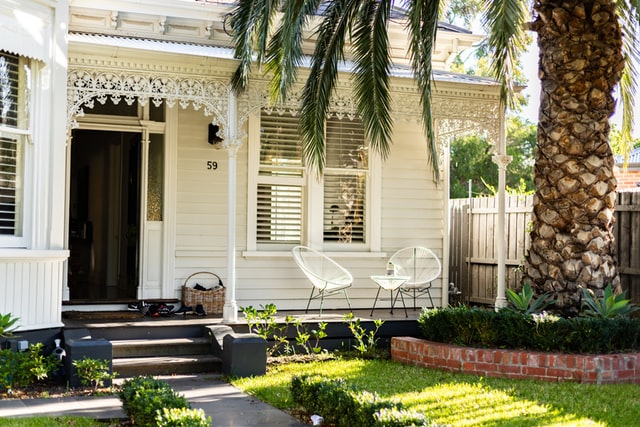Garden And Outdoors
This is an excerpt from the Book called “Reimagine Redesign Remodel” by Rosemary Bakker. Continue reading to learn more about Garden And Outdoors, thanks to the author.
Entryways, Gardens, & the Outdoors
Enjoying the outdoors is one of life’s greatest pleasures—and it’s good for you, too. The healing qualities of nature promote well-being and relaxation: keys to a healthy lifestyle.
In most standard homes, though, entry ways, exterior stairs, and uneven walkways can make getting outside and moving around outdoors and exasperating challenge. The universal home, on the other hand, has accessible entrances and gardens so people of all ages and abilities can delight in nature and safely appreciate its benefits.
From sprucing up a deck to building a garden patio, this chapter features design ideas that can enhance your time outdoors.

No-Hassle Entry Ways
The ability to come and go as we please is a freedom most of us take for granted. Even if climbing stairs isn’t a problem for you at this point, the unpredictability of life means things won’t always stay this way. That’s why it’s important for you home to have at least on accessible entryway. In this section. We’ll explore a variety of ways to create a no-step entrance, including sloped pathways, landscaped ramps, as well as porch and stair lifts. Well’ also discuss universal design practices that can increase the safety and usability of your existing stairs.
Sloping Pathways
If you’re remodelling, talk to your architect about designing a sloping no-step entryway. Slope the land up to the doorway and line the pathway with flowering plants and shrubs. The easiest lope for walking or wheeling is 1 inch (2.5 cm) of rise for every 20 inches (51cm) of walkway. Depending on how the home is sited, you’ll need to make sure to slope is sufficient to drain water properly.
Ramps
Contrary to popular belief, ramps can look great and preserve the style of your home. For a seamless, stylish look, border the ramp with small tress and planter boxes filled with flowers, and integrate decorative details form your porch railing and balustrade into the ram’s design.
Ramps, however, aren’t suitable for every person or house. Some people with balance problems prefer using stairs—so make sure your stairs pass the safety test. And not every home has the space for a ramp, especially in urban areas. Very long ramps can be unsightly, so the rule of thumb is: if your stairs are over 30 inches (76cm) high, install a porch or stair lift instead
Below are some general tips for adding a ramp to your home. Check to see if you need a building permit, as some communities do require one. Of course, you’ll also want to consult an experienced builder to be sure the dimensions, materials, and design will work for you home, climate, and lifestyle.
Slope Of Ramp
Although building codes allow ramps to be built with a slope of 1 inch (2.5cm) for every 12 inches (30.5cm) in length, wheeling someone up or down a ramp this steep takes considerable strength; plus, a wheelchair can roll out of control, or you can injure your back pushing someone up an incline. A slope of 1 inch (2.5cm) for every 20 inches (51CM) in length is easier to use, but better suited to a one-step entrance.
Length of ramp
You can build long ramps in an L-shape or a switchback pattern; these designs have a run of ramp and then a 900 or a 1800 turn, followed by another run of ramp. Very long ramps are less attractive and more impractical than short ones. If your setback or your lot slope requires such a long ramp, consider a lection less prominent than the front of the house, if possible.
Materials For Ramp
Let personal style, safety, and ease of maintenance guide your decisions when choosing the ramp’s materials.
- Treated wood requires annual sealing or painting. Use paint that dries to a nonslip, textured finish (due to the addition of sandy grit) to avoid warping, and mold.
- Composite wood products require maintenance ( such as annual prating or sealing) and are available in tiful patterns and weathered finish made of recycled materials—such plastics, scrap wood, or saw without any chemical preservation the surfaces are pebbly taxied and slip-resistant. Initially more sive than treated wood, economic products may be less expensive and long run because there are to maintenance costs.
- Portable metal ramps are Manufactured in sections, easily installed, and ideal in certain situations. For example. You can use a short portable metal ramp for a one-or two-step apartment entranced. And the tuck it away when no longer needed. You can temporarily use a longer metal ramp at your front or side door to allow a parent (who can’t climb stairs) to easily come and go while recuperating after surgery in your first-floor den.
For more information on building a wooden ramp for your home, refer to the center for Universal Design’s online manual “Wood Ramp Design: How to Add a Ramp That Looks Good and Works Too” (design.ncsu.edu/cud/pubs p/docs/rampbooklet296 final.pdf).


Porch & Stair Lifts
There are several types of electric lifts that raise a standing or a seated person onto a porch when stair climbing is no longer an option. For wheelchair users who can’t easily transfer, you’ll want a wheelchair lift that allows the person to remain seated during transit. When looking for a lift that’s right for your situation, buy the best you can afford; a quality lift should require only minimal maintenance. And, of course, talk to the dealer about specific space requirements for the type of lift you’re considering, including the minimum-size porch landing needed.
Stairways
Not all home are well situated for a sloped pathway, so if you or your gusts climb stairs, you’ll want the safest stairs possible. We all know the serious consequences of climbing stairs in the dark, especially if they’re slippery or without handrails. You can be seriously injured falling down stairs, so stair safety is a key element of the universal home.
Quick Fixes
No-Cost Ramps
Explore no-cost funding and labor sources, such as local churches or civic organizations, for installing a ramp.
Stair Safety Test
When conducting your exterior-stair safety test, start by reviewing safer stairs in then answer the following questions as your decide what features to improve.
- Are your handrails the right length? Yes No
You need to extend the handrails on both sides into the landing area; they provide stability and help you balance once you’re on the landing.
- Are the treads/steps nonslip and in good condition? Yes No
Falls can happen easily if your foot gets caught on a small crack or if you slip on wet leaves or ice. Repair broken or loose bricks, stones, or cement, so no one has a preventable fall. To help keep your steps ice free, trim nearby tree branches to maximize the sunlight. Melting the ice, and keep a good broom and a box of rock salt handy. For enhanced safety in snowy climates, consider a heated rubber front-door mat and stair treads (plugs into a standard 120 v or 240 v outlet) that help melt snow and ice.
- Are the risers closed? Yes No
You can easily catch your feet in open risers (the vertical section supporting a step) when you’re climbing the stairs, so close them off.
- Is there good lighting on the stairs and landing? Yes No
Climbing stairs in the drake is dangerous for anyone, so good lighting is a must. Make sure the stairs and the landing have even lighting; shadows can be confusing, especially on stairs. Depending on the design of your porch, consider sconces on both sides of the door, an overhead canopy lights, and lights on or along the steps. A relatively now type of stair light in stalls directly into the stair’s risers or along the sidewall of each step. Before buying, you’ll want to check to see if these lights can be installed in your existing stairs.
Stair lights are now available want integrated open-patterned risers that allow abundant light to pass through choose a simple pattern especially for individuals with low vision or mentia.
How did you score on the Safety Test? This is one test you relay do want to ace if you checked no any of the questions, take action to fix the problem.
New Stair
If you’re installing new stairs, design them to be uniform in height and without nosing (a rounded projecting edge on the treads). With nosing, it’s too easy to get your foot caught when climbing. Also, install stairs that have closed risers,
If you use a walker, you may find 4inch (10cm) riser height easier for maneuvering than the standard 7-inch (18cm) height. Similarly, a wider tread—18 to 34 inches (46 to 86.5cm), instead of the standard 11 inches (28cm)—will allow the base of the walker to rest on a single stair. Check with an occupational therapist, who can offer other useful design suggestions, especially for accommodating welders on stairs.
Front Porch
A front porch is a great place to sit and relax, engage with the world outside, or visit with friends and family. It also serves the practical purpose of providing shelter in stormy weather when you’re searching for your keys or on a snowy evening when visitors ring the bell.


